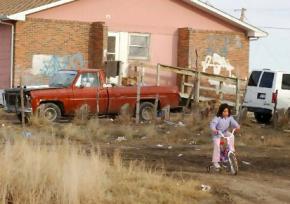Finding facts about stolen land
reports on a UN investigation of conditions for Native Americans.
THE OPPRESSION of American Indians was the cornerstone of the conquest of North America. For its part, the U.S. government signed over 300 treaties with Native tribes and broke every single one of them. The U.S. stole sacred land and killed off nations--not only the people, but their culture and livelihood.
For the first time, the U.S. has allowed a United Nations fact-finding mission to determine the impact of the passage of the proposed Declaration of the Rights of Indigenous People.
The 12-day fact-finding mission was performed by James Anaya, a professor of human rights law and policy at the University of Arizona. This mission took Anaya all over Indian Country and up to Alaska to determine the experience of Natives in this country. He will be presenting his finding in September to U.N. Human Rights Council. Reflecting on his mission, Anaya said on Democracy Now!:
The indigenous peoples of this country--the Native Americans, American Indians, Alaskan Natives, Native Hawaiians--suffer from poverty, poor health conditions, lack of attainment of formal education, social ills, at rates that far exceed those of other segments of the American population.

ONE OF the headline-catching recommendations from Anaya was that the U.S. government return some stolen land to Native tribe as a way forward toward reconciliation. One specific piece of land recommended is Mount Rushmore, which is located in the Black Hills National Park in South Dakota--historically sacred land for the Lakota (Sioux). This land was stolen after gold was found in the Black Hills, in violation of the Fort Laramie Treaty of 1868.
In 1980, the Supreme Court decided that the seizure of the Black Hills from the Lakota was illegal and stated that the U.S. needed to compensate the Lakota for the land. The Lakota refused the money, instead demanding their land back.
The findings of the UN mission are no surprise since the U.S. was founded on stolen land--along with stolen labor. The U.S. continued to expand westward in an effort to find new markets and new resources.
In 1871, the U.S. discontinued the treaty process with Native tribes. From this point, the policy of the U.S. government was to assimilate Indians into white society. Young Indians were forced to go to boarding schools, where they had to cut their hair and were forbidden from speaking their native tongue.
It wasn't until the passage of the Indian Reorganization Act of 1934 that Indians were given the right to vote, which makes them the last minority in this country to win the franchise. The same law allowed tribes to have democratically elected councils to govern their reservations. Though these councils were set up by the U.S. government, and often used by them, this was a step towards sovereignty.
The 1970s saw a rise in American Indian struggle. This came in the form of the American Indian Movement (AIM), which looked to bring the injustices endured by Native peoples to the forefront again. Actions such as the occupation of Alcatraz Island, the Bureau of Indian Affairs and Wounded Knee, the site of the Wounded Knee massacre in 1890, brought the issue of Native rights back in the mainstream.
As a result of this pressure, the U.S. government passed the American Indian Religious Freedom Act of 1980. The act states:
That henceforth it shall be the policy of the United States to protect and preserve for American Indians their inherent right of freedom to believe, express, and exercise the traditional religions of the American Indian, Eskimo, Aleut, and Native Hawaiians, including but not limited to access to sites, use and possession of sacred objects, and the freedom to worship through ceremonials and traditional rites.
This act supposedly gave Native Americans access to sacred sites--but that's often at odds with the interests of the government when the sites are on line that is rich in natural resources. One example is uranium mining in the Navajo Nation in Arizona and New Mexico. The mining for uranium not only destroyed the land and the health of many Navajos, but it helped fuel the U.S. war machine.
In 2010, President Obama stated that the U.S. government supported the UN Declaration of the Rights of Indigenous People. To get an idea of the what the declaration conveys, Article 3 states:
Indigenous peoples have the right to self-determination. By virtue of that right, they freely determine their political status and freely pursue their economic, social and cultural development.
The reality is the administration has done very little to push for the rights of indigenous people. It passed the Tribal Law and Order Act, which further militarizes reservations with the addition of more police and judges. This seems more important to federal officials than addressing housing shortages and astronomical unemployment rates on reservations.
The recommendations by the UN mission will put the U.S. government on the spot. Will it actually pursue reconciliation, reparations and sovereignty for American Indian Nations?
Although it's unlikely that the U.S. will be responsive to a UN recommendation, the results of this mission create an opening to bring indigenous issues back into the mainstream debate. The indigenous people of this country are still fighting the same fight as their brothers and sisters of the past. We need to stand up for their rights against a system that continues the exploitation of Native people and land.


